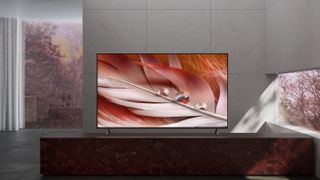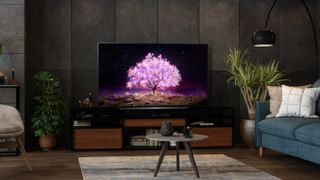
The Sony PS5 can crank out incredible visuals. You'll witness the most realistic reflections you've ever witnessed in a game, dazzling HDR and textures worthy of the title "next-gen". It makes a great home entertainment center too.
However, to get the most from a PS5 you need the right TV. Finding that TV can be more difficult than picking a phone, because the TV world is packed with jargon and other techy terms most people don't know.
We're going to take you through the parts that matter most when shopping for a TV to match your games console. We'll tackle aspects like why a 120Hz refresh rate matters, what VRR means, why you might choose an LCD or OLED TV, and which screen size you should get.
Here are the six things you need to think about when shopping for a TV that will show off your PS5 at its best.
1. Screen size
If you haven't upgraded your TV in many years, you may think it's time for a change in size. 55 inches is the default these days. This is not just about popularity. It also means you tend to get the best value from a 55-inch set, not least because more of them are produced.
65 inch sets are even better if you have the room, and 48-inchers are the step down. These are the three sizes we recommend to about 98% of people.
What your PS5 wants is pretty simple. It wants more because, just like movies, games tend to only look more impressive when the picture is bigger. However, your TV has to get on with the room as well as your console.
Get daily insight, inspiration and deals in your inbox
Get the hottest deals available in your inbox plus news, reviews, opinion, analysis and more from the TechRadar team.
The best way to see if the set you have in mind will fit is to use a tape measure. You'll find the dimensions for just about any TV on its manufacturer's website.
This should be the point for AR, augmented reality, to step in, but there aren't actually many great AR TV-fitting apps that let you point your phone at a wall to see how it will look in reality.
However, it's worth giving LG TV & Audio AR Experience a download on your phone if you don't have a tape measure to hand.
It lets you map a TV into your room through your phone's camera. And as 55-inch and 65-inch TVs are roughly similar in size, it doesn't matter that much if you don't end up picturing the exact set you'll buy.
2. Refresh rate

Here is an important one for big gamers. You ideally want to match a PS5 with a 120Hz TV. This means it can fresh its screen image up to 120 times a second.
The PS5 plays some games at 120 frames per second, so you need a TV with a 120Hz refresh rate to actually serve up the action at same pace as the console. Such high refresh rates are great for twitch response and competitive games, and 120fps modes are seen in titles like Borderlands 3, Destiny 2 and Call of Duty: Black Ops Cold War.
Should you immediately discount any TV without 120Hz? Not necessarily, particularly if you are buying a lower-cost one. You should definitely put it near the top of your list if you are buying a top-end set, though.
VRR is just as important. This stands for variable refresh rate, and it lets the TV effective sync-up with the frame rate of your games. It avoids the tiny stutters that can otherwise occur, and that’s crucial because a consistent frame rate is actually more important than an ultra-high one when it comes to your actual experience.
The PS5 does not support VRR at the time of writing, but an update to enable it is expected very soon.
3. Panel type: LCD or OLED?
When we boil the TV decision down to its fundamentals, there are two types of TV panel, LCD and OLED. And while the TV companies come up with all kinds of sub-technologies and terms to make their sets seem unique, the core appeals and drawbacks of OLED and LCD largely remain.
For playing in dimmer rooms you cannot beat an OLED. They have light-up pixels, leading to cinema-beating black levels and technically infinite contrast.
However, the best LCD TVs can go brighter, resulting in a better experience in well-lit rooms. And HDR that might just melt your eyeballs clean out of your head.
This is the decision you need to make when shopping for a high-end TV. But if your budget is smaller, you actually need to choose between two types of LCD TV panel, IPS and VA.
IPS LCD panels are used in loads of phones and tablets, and are a good idea if you need a TV that people can see clearly from pretty much any angle.
However, VA panel TVs offer better contrast, with a narrower viewing angle: better for cineastes, less versatile for large families. Check out our TV reviews and you’ll see we cover aspects like viewing angle and contrast.
- OLED vs LED vs LCD: which TV tech should earn a place in your living room?
4. Resolution: Should you go 8K?

Resolution tells you the number of pixels in a TV. This used to be one of the main points of consideration when buying a set, but not at the moment.
Almost all TVs are 4K. There are a few low-end 1080p and 720p ones, which we wouldn't recommend for use with a PS5. You can even get an 8K resolution TV, but these are mostly only a good fit for those spending a huge amount of money on a very, very large set.
While you can buy some relatively affordable 8K TVs these days, we recommend putting your money into a higher-quality 4K one. The PS5 cannot actually output 8K resolution yet.
5. Sound considerations
If you don't have a surround sound system or a soundbar, it's a good idea to set aside some cash from of your TV-buying budget for one. Some TVs have decent built-in speakers, but modern TV design is no friend to them.
TVs are often made thin, so they can be mounted to the wall without becoming a distraction. But speakers need a little room to shine, as the space inside a speaker cabinet is just as important as the driver itself.
Assuming you are not going to spend as much on a sound system as the TV itself, the easiest way to hook one of these up is through ARC.
This is a feature of some HDMI ports on a TV. You plug in your soundbar or receiver to this HDMI and the TV routes through the audio from the console.
For the best quality, make sure your TV has "eARC", which is the latest version of this technology. It allows higher quality audio to be piped through to your soundbar.
6. What makes a good HDR TV?
High dynamic range, HDR, is one of the big innovations of recent years in gaming, from an image quality perspective. It increases the amount of detail in the brightest parts of the image, called specular highlights, and the shadows.
Almost all TVs have HDR these days, but in some it barely has an effect and can actually make the image look worse in some cases. Three factors determine good HDR in a TV: high brightness, high contrast and the ability to render deep color tones.
Sets that nail these areas best today are high-end, bright OLED TVs and LCD TVs with mini LED backlights like Samsung's Neo QLED range.
If your budget won't stretch to one of those, hunt down a TV with local dimming. This denotes an LCD whose backlight brightness can be controlled in "zones", rather than making the entire panel dimmer or brighter.
Without some level of backlight control, you're not going to get a truly great HDR experience from your PS5.
Andrew is a freelance journalist and has been writing and editing for some of the UK's top tech and lifestyle publications including TrustedReviews, Stuff, T3, TechRadar, Lifehacker and others.


